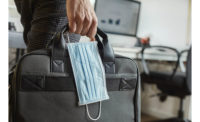According to a report by staffing firm LaSalle Network, 70 percent of CEOs plan to have their employees back in the office by fall of this year. And with others saying they expect employees to return once they receive their vaccines, it’s likely that the majority of offices will be filling up throughout this summer.
Still, many Americans are hesitant to return to the office due to health concerns. This presents a large opportunity for security professionals to sell solutions that can help calm these fears. Here, learn about five security offerings that promote a safe return to the office.
1. Mobile Credentials
While traditional access credentials were already being phased out at more tech-savvy offices before 2020, the pandemic made mobile credentials even more enticing. Not only are traditional key cards a security concern since they are easily lost or stolen, they’re also just another surface that can collect germs — a scary thought in the ‘new normal.’ Credentials that employees can access via their mobile phones are more convenient for employees, and they can help prevent the spread of germs. Plus, employers can send temporary mobile credentials to visitors that expire once their stay is over.
2. Frictionless Entry Control
After over a year of COVID bubbles and staying home, touching a door handle can be an almost frightening thing for employees. Thankfully, there are plenty of touch-free entry options now on the market. Encourage your customer to consider automatic door openers, wave-to-open doors or maybe even a revolving door to reduce touch points and bring peace of mind to employees.
3. New or Updated VMS
If your customer still has a basic visitor management system (VMS) let them know that it’s time for an upgrade. Over the past year, a plethora of updates have been made to many manufacturers’ VMS offerings, and many of the new features are meant for the post-COVID world. Maybe they want employees and visitors to answer questions about their health or who they’ve come in contact with before entering the office. Or, they can use their VMS to ensure capacity limits aren’t surpassed. And in the unfortunate case of a COVID-19 outbreak, the VMS can perform contact tracing, and produce a report on who may have come into contact with the infected individuals.
4. Thermal Detection Cameras
An early star of the COVID-19 crisis, thermal detection cameras are less tedious than handheld temperature scanners, and can help prevent an infected person from entering right at the front door. While some of the thermal detection cameras that first hit the market weren’t very accurate, manufacturers have now had time to refine their offerings, and the solutions still available are tried and true. And even after the coronavirus pandemic (hopefully eventually) ends, thermal detection cameras can continue being used to prevent the spread of other diseases.
5. AI Analytics
Analytics are an affordable and easy addition to customers’ existing surveillance cameras. Powered by artificial intelligence and deep learning, analytics can transform traditional cameras into the ultimate multi-taskers. They can detect whether a mask is being worn correctly, if social distancing requirements are being followed and whether occupancy limits are being surpassed. And the cherry on top? Cameras can then produce data reports on any violations of rules set, along with occupancy information.







